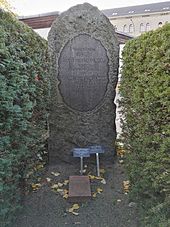Friedrich August von Staegemann

Friedrich August von Staegemann (born November 7, 1763 in Vierraden , Uckermark , † December 17, 1840 in Berlin ) was a Prussian civil servant , secret finance councilor and diplomat .
life and work
Staegemann came from a family of preachers and teachers . He lost his parents and was given away by relatives to Schindler's orphanage in Berlin when he was ten. After graduating from high school at the Gray Monastery , he studied law at the Friedrichs University in Halle . In 1785 he proposed as court clerk in the East Prussian government (judicial authority) a the civil service. He became a criminal adviser and syndic of the East Prussian General Landscape Directorate . In Königsberg he also met his future wife Elisabeth Graun . As "one of the noblest female figures of the time" she gathered a circle of respected and important personalities, including Immanuel Kant .
1806 to go Appointed finance advisor, Staegemann was appointed head of the Prussian Bank to Berlin. In this function he met Napoléon Bonaparte , who demanded contribution after the victorious battle of Jena and Auerstedt . At Prince Hardenberg's suggestion, Staegemann became a member of the Combined Immediatkommission for the reorganization of the Kingdom of Prussia in 1807 . Staegemann worked intensively on the Stein-Hardenberg reforms . In 1807 he drafted the October edict for the liberation of the Prussian peasants. In 1808 Staegemann was appointed Oberfinanzrat and in 1809 was promoted to the Privy Council of State. In 1811 he became a member of the German Table Society . In 1812, von Staegemann, as chairman of the finance party, worked on the reorganization of the property tax and asked Salomo Sachs to submit suitable proposals that Sachs was able to implement immediately. In 1813 he took part in the preparation and implementation of the wars of liberation . In the subsequent redesign of Europe at the Congress of Vienna , he and his State Chancellor Hardenberg represented Prussia's interests. In 1814 he was the Prussian envoy at Buckingham Palace . In the second half of 1815 he took part in Paris in the negotiations for the Second Peace of Paris . In 1816 Staegemann was awarded for his services by King Friedrich Wilhelm III. ennobled . In 1817 he joined the newly created Council of State . 1819–1820 he headed the newly founded Allgemeine Prussische Staatszeitung .
Staegemann was one of the champions for a constitution and publicly advocated freedom of the press and tolerance. Artists like Heinrich von Kleist and intellectuals like Achim von Arnim , Bettina von Arnim and Clemens Brentano frequented his Berlin house . Staegemann moved Hardenberg, Friedrich Wilhelm III. to wrest the constitutional promise on May 22, 1815; his rupture had serious consequences.
Staegemann also wrote patriotic songs and love poems. The war songs (1814) are named as his best poetic achievement . In addition, from 1811 to 1817 he published his poetic works in the Berlin Muses Almanac .
Friedrich August von Staegemann died in Berlin in 1840 at the age of 77. He was buried next to his wife, who died in 1835, in Cemetery III of the Jerusalem and New Churches in front of the Hallesches Tor . The granddaughter Marie von Olfers (1826–1924) is also buried here. The final resting place of Friedrich August von Staegemann (grave location 341-AL-14/15) is dedicated to the State of Berlin as an honorary grave . Since Staegemann was made an honorary citizen of Berlin in 1835 , the dedication - in contrast to the majority of Berlin's honorary graves - is not limited in time.
Quote
"It is peculiar that a poor boy raised in an orphanage, whose misshapen feet almost completely prevented him from walking, not only reached one of the highest positions in the state, but also won the love of one of the most beautiful, most sought after and most gifted women"
Works
- War chants from the years 1806–1813 (works included: War songs for Schill and his companions in arms, 1809 ). [Waisenhaus-Buchh.], Germany [i. e. Halle] 1813, digitized
literature
- Hermann von Petersdorff : Staegemann, Friedrich August von . In: Allgemeine Deutsche Biographie (ADB). Volume 35, Duncker & Humblot, Leipzig 1893, pp. 383-389.
Web links
- Wilhelm Dorow (ed.): Letters from the Royal Prussian Legation Councilor Karl Ernst Oelsner to the real secret councilor Friedrich August von Staegemann from the years 1815 to 1827. Teubner, Leipzig 1843
Individual evidence
- ↑ Karin Schneider, Eva Maria Werner, Brigitte Mazohl: Europe in Vienna: Who is Who at the Vienna Congress 1814/15 . Pp. 289-290
- ^ Stefan Nienhaus: History of the German table society . P. 17
- ^ Herbert Meinhard Mühlpfordt : Königsberg from A to Z - a city dictionary . Leer 1972
- ^ Hans-Jürgen Mende : Lexicon of Berlin burial places . Pharus-Plan, Berlin 2018, ISBN 978-3-86514-206-1 , pp. 245, 247.
- ↑ Honorary graves of the State of Berlin (as of November 2018) . (PDF, 413 kB) Senate Department for the Environment, Transport and Climate Protection, p. 84; accessed on March 30, 2019. Regarding the non-time limit for honorary graves for honorary citizens, see: Implementing Regulations for Section 12 Paragraph 6 of the Cemetery Act (AV Ehrengrabstätten) (PDF, 24 kB) of August 15, 2007, Section 4; accessed on March 30, 2019.
| personal data | |
|---|---|
| SURNAME | Staegemann, Friedrich August von |
| BRIEF DESCRIPTION | German politician |
| DATE OF BIRTH | November 7, 1763 |
| PLACE OF BIRTH | Vierraden , Uckermark |
| DATE OF DEATH | December 17, 1840 |
| Place of death | Berlin |


